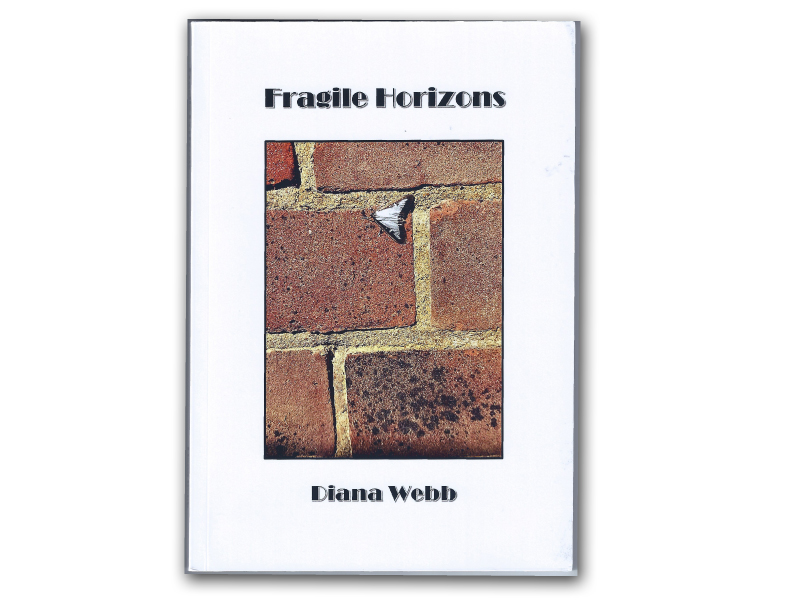
Book Review: Fragile Horizons
By Diana Webb
Published by the Magic Pen Press
44 Lattice Ave.
Ipswich, Suffolk, Great Britain
2022, Paperback, 114 pages
ISBN: 978-1-8380312-4-4
£7.99 for U.K. orders, checks payable to General Editor John Gonzalez
E-mail Publisher for Ordering Information
Reviewed by Rich Youmans
Diana Webb has been writing haiku and haibun for several decades now, and during that time her work has gained wide recognition. That’s especially true of her haibun, which appears consistently in many journals (including cho) and has won several awards (including the Grand Prix of the Genjuan International Haibun Contest). She dedicates her latest book, Fragile Horizons, to a host of mentors and companions who have helped her along that path. Among them is the late Ken Jones, the noted poet, zen monk, and former editor of this publication, who taught her to “envisage haibun as ‘haiku dancing with prose.'”
It’s a lesson that Webb has obviously taken to heart, as seen in this latest collection. Reading through it, you get the feeling that you’re moving in step with a partner who has learned her basics well: how to keep the rhythm of that dance, to move away without breaking the connection. Every once in a while she shakes it up, employing different structures—mostly notably toward the end of the book, with long-form sequences she calls “haibun novellarettes.” It seems as if Webb wants to explore the art of haibun from every angle possible, just as a dancer might move from two-step to waltz to jitterbug and back.
While not formally divided into sections, the book essentially has five parts. Four contain individual haibun, all loosely connected to a theme, with each section led off by a quartet (the form created by Danish poet Johannes J.H. Bjerg, in which single sentences appear above and below two interlocking haiku, their lines zippering into one another). The final section contains four novellarettes. There’s also a single haibun, “Grains,” that kicks off the entire collection and serves somewhat as an epigraph.
Grains
Alum Bay on the Isle of Wight. Excitement of scraping the famous colored sands, layer by layer into a test-tube shaped container to keep as a souvenir.
taking it in
this evening’s
strata of skyLearning that the poet Tennyson once lived nearby those multi-stranded cliffs. William Blake would never have worn the Laureate’s crown. From somewhere a dream of haiku poets in the running.
hourglass
in the space of a breath
words sift through
This haibun provides a good entry into some of the key aspects of Webb’s style. She knows how to say just enough in her often elliptical prose. Famous people (especially poets) and prominent landmarks from Webb’s native England sometimes appear in her work, and in this case she uses the setting to muse on the position of poet laureate (with a cheeky push for haiku to be given its due). The reference to Blake seems to come out of the blue, but that of course brings to mind his famous line, “To see a World in a Grain of Sand,” and Webb takes those grains as a running theme throughout title, prose, and haiku. It’s a well-wrought piece, but I especially like how the haiku resonate—how the first poem connects the layers of colored sands with the strata of sunset colors, and how the final haiku transfers the grains of sand into an hourglass, introducing the element of time (“And Eternity in an hour,” as Blake would say).
This concept of seeing the wonder in everyday life seems to carry throughout the book. That’s especially true in the first “section,” where Webb shows how commonplace objects contain additional dimensions. In colored glass ware, she finds “sea transparencies through which to see within beyond.” Elsewhere, “first poppy / petals erupt / from a crack in the wall.” The book’s title poem conveys well this search for glimpses, no mater how fleeting, of the mysterious and miraculous:
Fragile Horizons
He saw it in the river when the sun shone in the reedy water. But it just rippled away and vanished.
He saw it in the leaves of a beech when the wind moved through. But it just shimmered away and vanished.
He saw it in the clouds surrounding the moon. But it just shifted to a long thin wisp and vanished.
charity shop find
from someone’s collection
a green glass horse
The book’s second section opens with a haibun that references The Dante Project at London’s Royal Opera House, a ballet that brings Dante’s Divine Comedy to life. It’s a fitting shift, as the haibun in this section focus on how art (especially dance, ballet in particular) serves as a conduit to the spirit. Here’s an excerpt from “Serpentine,” which shows Webb’s prose at its most delicate, the lines floating like strands of gossamer:
as mists sift through horizons drift away to usher sunlit mornings to our footpaths
the sheen
on underwater pebbles
celandineslithe lithography of a yellow rose as spin of limb and scent of petals intertwine
raindrop
shot through with sunlight
dancer to dance
The art forms range from dance to music to textiles to ceramics, but the goal seems to be the same: to transcend the commonplace and enter a realm of spirit.
in progress
her body becomes a ripple as it waits to be clothed with feathers her partner comes and fingertip to fingertip, they dance now interlaced now pulled apart encircling until he spins away as she abandoned swirls herself in cloths of mist becomes eclipse of clay that spins and spins and settles slowly on a wheel of time
rimmed with snow
a rill
of birdsong
The third section of the book contains mostly haibun that feature children (perhaps a return to Blake’s “innocence”). There’s perhaps no time in life as wondrous as childhood, when we’re looking at everything anew and searching for what’s next, and I find Webb particularly good at writing about this. (Before finding haiku, she wrote several books for primary-school-age children.)
Drawn in Parallel
How tiny fingers love to hold a stalk while blowing time away or crayon a yellow disc until it shines.
in every window
the low sun’s glory
roadside dandelion
From innocence we go to experience: the fourth section returns to haibun with an adult perspective, often from the later years of life. That running theme of seeing beyond the immediate to the infinite is still there, though tempered at times with the poignancy of loss or of one’s own impending passing. Here’s an excerpt from “Legacy,” which shows Webb in a more narrative mode:
In the last decade of his ninety odd years, with only the weekly visit from his only offspring to brighten his days, the widower living alone, has amassed quite a collection of jigsaws of famous paintings. At the top of the last pile on the right, still sellotaped in place, pristine, unopened like all the others: Mona Lisa; Sunflowers; Haywain; Fighting Temeraire.
“I’m saving them up for a rainy day” he likes to say when she asks him.
This year, on his birthday, as always expected, his daughter Lizzy brings her father another, a special favourite, which he’d often taken her to the Tate to see, because the model who had nearly caught her death from the cold in a bath of water, shared her name. But he barely gives it a second look and just continues staring out of the window as the clouds darken.
all the spaces
between the raindrops
a different pane
As shown in the excerpts above, Webb modulates her style as needed—from storytelling mode to impressionistic and almost ethereal poetry. She also varies the structures of her haibun. In addition to the quartets that serve as frontispieces, she offers gembun (i.e., one sentence plus a haiku, a structure created by the poet ai li), braided haibun (with individual lines of the haiku dispersed among the prose), and some ekphrastic work. She is definitely not afraid to experiment. Take “Triveni,” for example. As I learned after a bit of research, the title refers to a form of Hindu/Urdu poetry containing three half-lines (“hemistichs”), in which the first two stand alone and the third adds a new dimension. Webb transforms the concept for haibun, weaving together a single sentence, three phrases, and a haiku—sort of a gembun-meets-braided-haibun-meets-triveni:
Triveni
From where I’m sitting three roads meet.
Towards the sea
a wave
Towards the hill
reaches its peak
Towards the ancient town with its view of the landmark spire.
ghost of a sunken church
Then there are the four “haibun novellarettes” that conclude the book. Whereas the previous four sections flow together, these final stories seem more like an addendum. Each is composed of a sequence of short, related prose pieces—expository paragraphs, dialogues, newspaper items, diary notes—punctuated by haiku. All of the stories incorporate haibun into their plots: A convent school student writes haibun and tanka prose for her English teachers. A woman records through haibun the intertwined lives of her ancestors. An artist seemingly stifled by religious ritual finds creative and spiritual fulfillment through jewelry, haiku, and haibun. Café patrons, detained by the police after a suspected murder, bide their time by writing haibun about Van Gogh’s “Starry Night Over the Rhone,” a reproduction of which hangs on the café wall. I appreciate Webb’s adventurousness here and the way she orchestrates the various pieces in each novellarette (sometimes taking the reader across decades). However, I found at times the plot connections to haiku and haibun a bit forced. With the novellarette set in the café, for instance, the main storyline—in which, after the discovery of foul play, the narrator suggests the patrons calm down first by practicing haiku and then by writing haibun—seems to be an overly elaborate (and somewhat contrived) way to lead into the eight ekphrastics at the heart of this piece. Still, the idea of creating stories through multiple haibun offers plenty of room for exploration, and I hope Webb continues to do so, perhaps someday attempting a full-fledged novella or even novel.
Webb does seem to be genuinely excited by the possibilities contained within haibun, and Fragile Horizons overall offers an excellent showcase of her work. For those who love the pas de deux between haiku and prose, Webb is a fine partner. Let her lead, and you may be amazed at what wonders you’ll discover.
About the Reviewer

Rich Youmans lives on Cape Cod with his wife, Alice. His books include All the Windows Lit (Snapshot Press, 2017) and Head-On (Red Bird Chapbooks, 2018).
